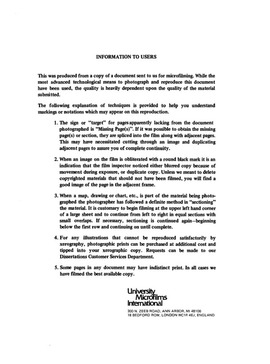| dc.contributor.author | Ramirez, Ernest Edward, | en_US |
| dc.date.accessioned | 2013-08-16T12:28:21Z | |
| dc.date.available | 2013-08-16T12:28:21Z | |
| dc.date.issued | 1981 | en_US |
| dc.identifier.uri | https://hdl.handle.net/11244/4872 | |
| dc.description.abstract | The principal problem of the study was the following: Are the leader behaviors of business administration graduate students and educational administration graduate students related to their loci of control? The theoretical construct of leader behaviors in the study was defined by the theory of leader role differentiation derived from the Ohio State Leadership Studies and was measured by the Leader Behavior Description Questionnaire-Form XII. The theoretical construct of locus of control was defined by social learning theory as explained by Julian B. Rotter and was measured by Helena Levenson's Multidimensional Locus of Control Scale. Additionally, the theoretical construct of interpersonal behavior as defined by Will Schutz's FIRO theory and measured by the Fundamental Interpersonal Relations Orientation-Behavior Scales was used to find out if interpersonal behaviors were related to either leader behaviors or loci of control. | en_US |
| dc.description.abstract | Three conclusions were derived from the findings in the study: (1)The contention supported by researchers associated with the Ohio State Leadership Studies that there are two basic leader behavior dimensions, Initiating Structure and Consideration, was not supported by the findings in the study. It appears that there may be more than two major dimensions, namely, a dimension which focuses on the aspects of the situation. (2)The findings showed that more variables were involved in the composition of leader behaviors for educational administration respondents than business administration respondents. (3)The findings showed that a relationship did exist between leader behaviors and loci of control for the 154 respondents, for example, Internality was the best predictor of the leader behaviors for the respondents in the study. | en_US |
| dc.description.abstract | The statistical plan for the study included the following types of statistics: (a)Pearson product moment correlational analyses; (b)Single classification analyses of variance; (c)Median split analyses; (d)Canonical correlational analyses; (e)Factor analysis; and (f)Multiple linear regression analyses. The most productive statistical analyses were the Pearson product moment correlational analyses and multiple linear regression analyses. The data gathered for 21 scales or variables on 154 graduate students from the University of Oklahoma showed the following results: (1) Business administration respondents and educational administration respondents perceived themselves as being internally-controlled, although the educational administration respondents showed a greater inclination to seek their loci of control in Powerful Others and Chance orientations. (2)The characteristics of the LBDQ scale of Consideration were statistically significant with the characteristics of Internality for educational administration respondents only. (3)The characteristics of the LBDQ scale of Initiating Structure were not statistically significant with any of the locus of control scales for either group of respondents. (4)The factor analysis of the twelve LBDQ scales yielded three factor scores which should be researched further. Of particular interest was the third factor score which was labeled the System-Oriented Dimension. When the third factor score was identified as the criterion variable and the locus of control scales and interpersonal behavior scales were used as predictor variables, the predictor variables yielded a multiple R of .81 and an R square of .66. These predictor variables were statistically significant at the .001 alpha level. (5)The characteristics of the interpersonal behavior of Wanted Control were statistically significant and inversely related to nine LBDQ scales for the educational administration respondents. Also the scores on Wanted Control for educational administration respondents were low. Researchers who are interested in the characteristics of interpersonal behaviors, especially Wanted Control, may want to do further research on these findings. | en_US |
| dc.format.extent | xix, 263 leaves ; | en_US |
| dc.subject | Education, General. | en_US |
| dc.title | The relationship of leader behaviors and loci of control. | en_US |
| dc.type | Thesis | en_US |
| dc.thesis.degree | Ph.D. | en_US |
| dc.thesis.degreeDiscipline | Jeannine Rainbolt College of Education | en_US |
| dc.note | Source: Dissertation Abstracts International, Volume: 42-02, Section: A, page: 0673. | en_US |
| ou.identifier | (UMI)AAI8116763 | en_US |
| ou.group | Jeannine Rainbolt College of Education | |
